Optoma UHZ50 Reviewed at $2,799.00
Product Name: Optoma UHZ50
Product Description: 4K Laser DLP Projector
-
Design - 9/10
9/10
-
Video Quality - 9/10
9/10
-
Ports & Connectivity - 9.5/10
9.5/10
-
OS, Apps and Features - 9/10
9/10
-
Price / Quality - 9/10
9/10
Summary
Reviewed at $2,799.00
Pros
- Solid laser light system
- Very low input lag
- Good out-of-the-box performance
- Affordable price
Cons
- High refresh rates are only for 1080p
- No HDMI 2.1
- Different HDMI support different functions
- Uninspiring built-in audio
Cheapest Places to Buy :
*We are a reader-supported website. When you buy through links on our site, we may earn a small affiliate commission at no extra cost to you. Home Media Entertainment does not accept money for reviews.*
We have seen a trend forming lately when it comes to new 4K pixel shifting projectors as we see a lot of them coming with a couple of characteristics that seems to indicate where technology tends to go. The first one is that an increased number of new releases have traded lamp for laser and there is a reason for that as laser projectors surely come with certain advantages over lamp based ones. The second is that more and more low cost projectors come with incredibly lower input lag numbers compared to previous offerings. And today in our Optoma UHZ50 review we will be testing such a projector that seems to confirm all the above.

The UHZ50 may seem to be a game oriented projector due to its low input lag and added gaming characteristics but the truth is that Optoma has created a projector that fits all needs, either it be for a home theater room or a gaming setup. And this is because the combination of its 4K XPR pixel shifting technology along with its DLP nature and laser light source makes the UHZ50 a very affordable and good performing projector for all kind of content. But we will dig deeper into its specs shortly.
So before we begin let’s see real quick what this new release from Optoma comes with. The UHZ50 is a 4K pixel shifting projector, it uses a single DLP chip and has a laser light source for extended usage without the need for a lamp change. The projector is capable of 4K@60Hz and can even support 120/240Hz but only in 1080p resolution. It uses Optoma’s own OS along with a marketplace from where you can download various apps while it also comes with enhanced gaming features that many gamers may find useful.
The Optoma UHZ50 seems a rather intriguing new release. It’s obvious that this model leans more towards gaming but the sum of its parts makes it a great overall performer and at a very affordable price. Is it really as good as it looks? Let’s find out…
Design
In terms of design the UHZ50 uses a completely new shell that looks like no other Optoma projector we had tested so far. Build quality is good enough and the projector seemed solid even though its whole shell is made out of plastic. Layout of all its components is more or less the standard so no surprises here but even this new look makes the UHZ50 feel fresh and not a reuse from previous years.
Optoma went for a more or less simple design with straight lines and very light curved corners. The UHZ50 comes with a size of 13.27″ x 10.43″ x 4.82″ (337 x 265 x 122.5 mm) with the feet included and a weight of 10.58 lbs (4.8 kg) making it slightly bigger that some other similar projectors like the Optoma UHD35 for example that we had tested recently.
The projector comes only in white color and its white plastic may seem a little cheap but really it is no different than many other projectors with a similar price tag. Its surface is using a mixture of glossy and some short of textured parts which adds positively to its looks but nothing that will wow you obviously.
It is using an asymmetrical design with the lens being placed on the right side of the front face with a small, squarish IR receiver siting to the left side of it. A completely white focus ring has been placed around the lens which is typical for Optoma and fits the design and color of the rest of the body.
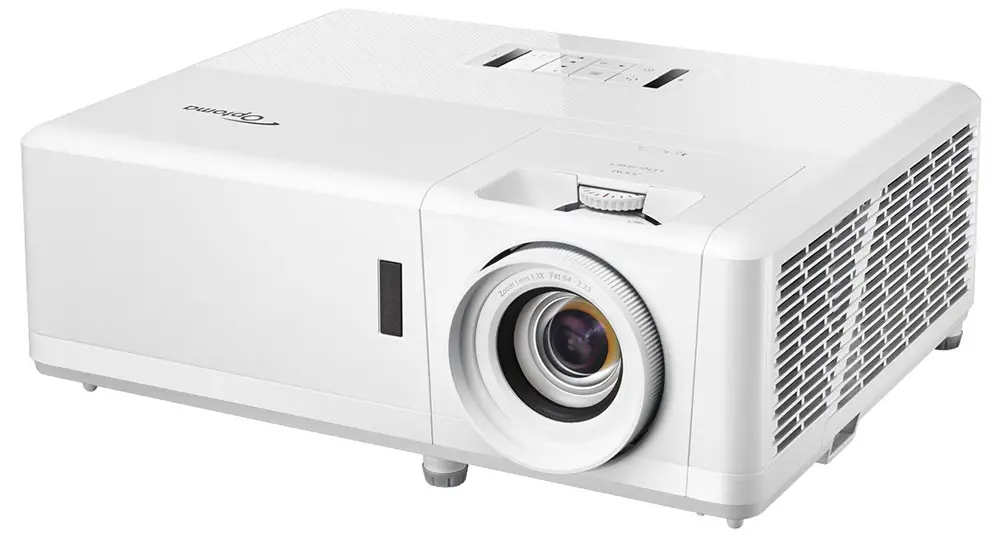
Ventilation is also pretty standard as the whole right side, as we look the projector from the front, is being used to let cold air in while the left side is where the hot air comes out. There are plenty of ventilation holes and the cooling solution keeps the projector at normal temperatures.
On the top side, exactly above the lens, we find the controls for the zoom which gives the projector a 1.3x optical zoom along with lens shift as the projector is capable of a 105%~115% in vertical. Unfortunately no horizontal lens shift in this one.
At the top side we also get the built-in controls which comes with a redesigned layout. An array of eight square buttons is complemented by two LEDs, one at each side, with the left one indicating the light source and the right one being for the temperature.
As for the available buttons we get a power button/LED, Menu, Enter, Info, Keystone correction, source selection and re-sync. Some of them have dual use and are used for navigating the various menus and settings also. Also right next to the buttons we get a second IR receiver that is used if you mount the projector on the ceiling.
At the back we find all the connection ports grouped together but we will talk about them in the appropriate section below. The UHZ50 is using three, one at the front and two at the rear, tilt-adjustment feet in case you plan on putting it on a furniture and want some easy and fast placement calibration.

As for the lens that is being used, the projector has a throw ratio of 1.21 – 1.59:1, ±3% with a projection distance of 1.2m – 8.1m for a 34.1″ – 302.4″ diagonal image size. From these numbers we see that the UHZ50 is offering more or less similar numbers to other projectors of the same category.
Optoma has officially rated the UHZ50 noise levels at 27 dB at typical level and 29 dB at max which are numbers that are a bit on the optimistic side. Noise usually comes from two sources in these projectors. The cooling solution and the 4K pixel shifting technology. That’s why usually these projectors are slightly louder than native 4K ones.
During our testing we can say that the UHZ50 could be slightly heard when in complete silence but its noise was completely masked during more action oriented scenes. We wouldn’t call it bothering and surely it didn’t affect our viewing experience but if you are expecting a completely silent projector you are not going to find it here. From 4 feet we measured its noise to be at 33 dB while in Eco mode this dropped slightly to 31 dB.
When it comes to the projector’s light source life this is where the UHZ50 distinguishes itself from most other lamp based DLP projectors. Having a laser light source it means no need for frequent lamp changes and Optoma rates the UHZ50 at 30,000 hours before its light source reaches its half brightness threshold which translates to roughly 8 hours of everyday use for the next 10 years!

As for the remote we were expecting to find the one we recently used in the UHD35 and that Optoma has used for many of its projectors but in fact the one that is included is that we had previously used in projectors like the Optoma UHD51A or the UHD52ALV and there is a reason for that. It seems that all projectors that come with online functionality including apps and an online marketplace, as the UHZ50, use the same kind of remote.
The one that comes with this projector has very smooth curves and round buttons with only symbols revealing the functionality of each button. Although for some this may be nice for others may be a bit hard to memorize these symbols and would prefer a short word to show each button’s functionality. In addition there is backlight functionality but the light it emits is more subtle compared to some other backlit remotes and surely doesn’t distract when used in a dark room.
We liked that Optoma used a new shell for the UHZ50 and didn’t recycle any of its previous designs. Quality wise you get the usual you should expect from Optoma so no real concerns here.
Video Quality
Technology used
In terms of the technology that powers the UHZ50 things haven’t changed much compared to other recently released projectors from Optoma. This means that under the hood we find a single 0.47″ 4K UHD DMD DLP chip from Texas Instruments that is responsible for displacing a full HD 1080p image in four different positions at very high speeds in order to produce the full 4K image that is very close in clarity and quality to a native 4K image.
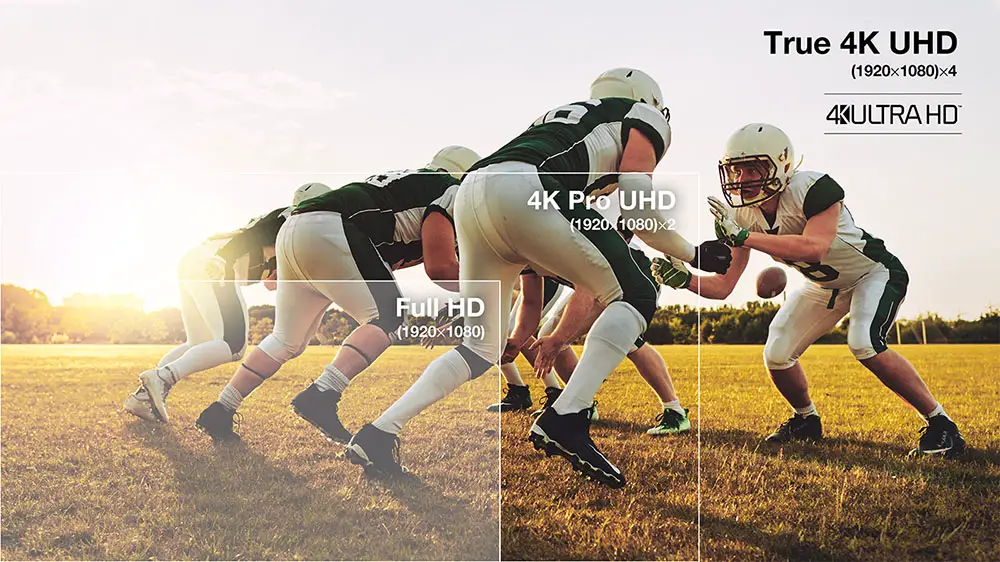
For those that don’t know what pixel shifting is, it was created by manufacturers in order to bring down the cost of 4K projectors by offering similar quality at sub-$2,000 levels. Nowadays we have 4K pixel shifters that are even close to the $1,000 limit so compared to a $5,000 native 4K projector the price difference is huge.
These pixel shifting projectors are usually distinguished in two different categories depending the type of pixel shifting technology used. There are projectors that shift the image only in two positions and these use slightly larger chips and are a bit more expensive while those that use the 1920 x 1080 x 4 technology tend to be cheaper without any meaningful loss of quality.
In general if you are considering a 4K projector but you are unsure about going for a pixel shifting unit we would say that its main strength is offering very close quality to a native 4K model but at a fraction of the cost. So if you are worried about your budget, a pixel shifter is ideal and you get a lot of value for money.
If there is one weakness these type of projectors have is that due to the high speed of the shifting technology noise is always higher than native 4K projectors so it’s always advisable to make a test hearing by yourself to determine if it bothers you or not.
4K UHD / HDR Content
Lately we have been using our 4K UHD copy of Aquaman when testing the various projectors we have but this time we thought to make a change and went for Bumblebee in 4K UHD that is of equally spectacular image quality.
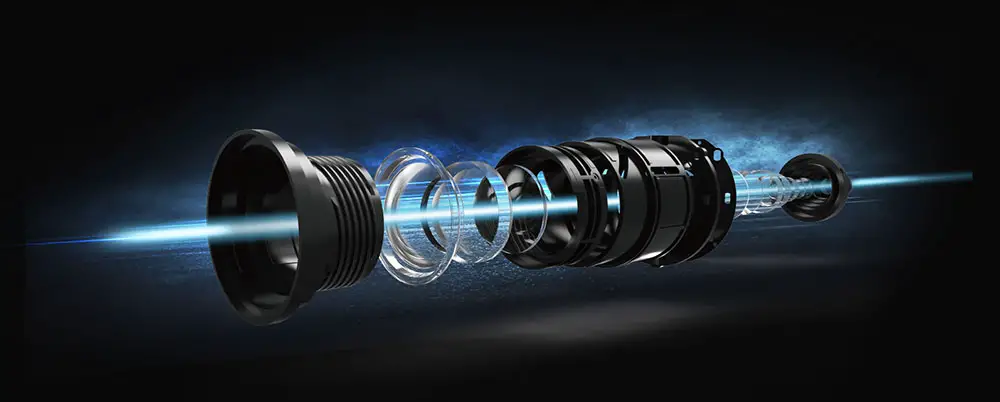
The opening sequence with the battle on Cybertron revealed what the UHZ50 could do in various areas and first of all the incredible details and sharpness of the picture. You could distinguish small irregularities on the metal surfaces of the transformers bodies while colors were pretty accurate and had nice pop. The sequence is pretty dark and it was a nice test for the projector’s black levels capabilities where it retained a lot of shadow detail.
Highlights that came in the shape of laser fire had good brightness and will surely impress you with their vibrancy. Overall the UHZ50 may not be the most bright of projectors but surely goes above the average reaching a level that most will find satisfying at this price range.
In terms of contrast ratio Optoma is rating the UHZ50 at 2,500,000:1. This number may seem extremely high but as always you should never take these numbers literally as each manufacturer tends to take measurements with different standards and different test conditions. In general we would say that from what we saw the UHZ50 is a step above what most low cost lamp based DLP projectors offer these days. Surely it cannot reach the black levels we have seen in some of Epson UB series of projectors but we would categorize this one somewhere in the middle of the two and considering its price this is surely a good thing.
When you are watching HDR content the projector can switch to the appropriate HDR display mode, if you have this enabled in the settings, and from there you can decide which HDR picture mode you like the most. Optoma offers four different modes with Detail, Film, Standard and Bright the ones available. This seems to work exactly the same as some previous Optoma models we had tested. And once again we find it better to adjust the HDR brightness than use any of these specific modes.

Lastly we should mention about the projector’s HDR protocols support which is pretty standard among most projectors nowadays either cheap or expensive. As such we get the HDR10 which is the basis for 4K UHD playback along with HLG which is used for broadcasting. No Dolby Vision or HDR10+ here unfortunately but most projectors don’t support these anyway.
Full HD / SDR / 3D Content
Obviously it’s not all about 4K content so we also tried some 1080p material and as we always do we used our Blu-ray copy of Oblivion for this test. The projector was equally capable here with good detailed images considering the source material. Material complexity and surfaces composition were clearly visible most of the time while color reproduction and accuracy were very good even if not pinpoint perfect.
Black levels and shadow detail were satisfying with many low lit scenes retaining a lot of their composure while color gradients were smooth and natural. Brightness was once again great and the projector can do equally good in both dark rooms and bright lit environments but obviously in a low lit situation things will surely look better. But this shows that the UHZ50 is an excellent projector no matter the ambient conditions.
Lastly we should not forget to mention that the projector also supports 3D and if you are still fond of your 3D collection the projector works miracles here. When a 3D signal is detected then the UHZ50 switches to the appropriate 3D mode. From what we saw during our tests brightness was good enough considering the lower output you get in 3D and we didn’t notice any major artifacts or crosstalk. Overall a very nice projector if 3D is your thing.

Color Coverage
In terms of color performance the UHZ50 is using Optoma’s DuraCore Laser Technology that uses a phosphor light source with a single blue light laser and a phosphor color wheel in order to create the Red, Green, and Blue (RGB) light beams necessary. This system seems to be very similar to the one that is used in the CinemaX P2 while Optoma claims the UHZ50 can cover 100% of the REC.709 and 85% of the DCI-P3 color space.
As we usually do, we will talk in more detail about the available color modes in our next section of the review but in terms of color performance and accuracy we would suggest you to use either the Cinema or the Reference mode as these two were far better than the rest while each one had certain strengths and weaknesses. It seems that Cinema mode had better greyscale while Reference mode had more accurate colors.
You could say that the UHZ50 had satisfactory out-of-the-box performance although you can further improve its performance by doing some deeper calibration if you are up for it.
One last thing to mention here is that as with all projectors that use color wheels there is a chance that you will be prone to see a rainbow effect which can be bothering to some. Not all people can see it and in our case we didn’t see it but some small percentage do see it and can be really bothering so make sure you are not prone to this or at least make sure you make a test run before purchasing in order to determine if it is a problem in your case or not.
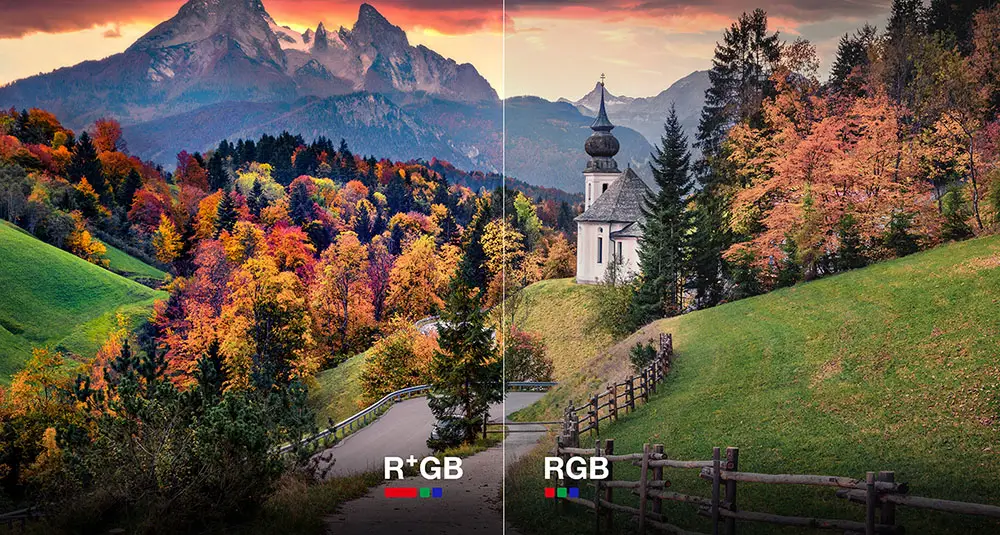
Brightness / Picture Settings
Onto our brightness tests now and the UHZ50 is rated by Optoma with a 3,000 lumens brightness which may not seem as high as some other lamp projectors that manage to go even higher. But you have to keep in mind that you are not going to find many laser based projectors with this brightness at this price range and also we have to see how close to these numbers its actual performance is.
Keep in mind that there are many factors that can affect brightness on a projector so the numbers we give are only for giving you a general idea of the projector’s capabilities and yours may differ in the end. When watching SDR content the available modes include Bright, Cinema, HDR SIM, Game, Reference and a User defined. The other modes like 3D, HDR and HLG are used automatically if the appropriate signal is detected. Lastly there are ISF Day, ISF Night and ISF 3D for those interested in professional calibration.
As always we use the widest angle along with Bright mode and Constant Power at 100% in order to get the maximum brightness and in this case we got 2,556 lumens which is pretty good even though still far from its theoretical output.
As it tends to happens with most projectors the Bright mode had a slight green tint to it and it was far from accurate although in a bright room it should still be usable. HDR Sim came in second with 1,714 lumens while Game came close third with 1,705 lumens. The last two modes would output the least brightness but were also the most accurate of them all. Cinema came next with 1,248 lumens and Reference was last with 1,137 lumens.
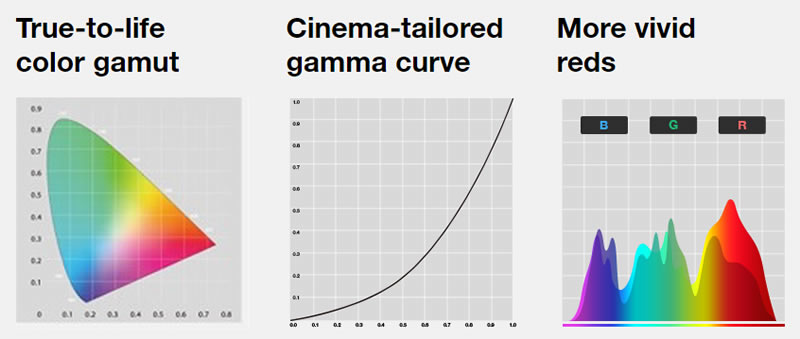
For HDR content you don’t have much choice as the HDR mode is engaged the moment it detects an HDR signal. As for SDR content we would recommend the Cinema or Reference mode. Both of them have certain advantages and disadvantages so we recommend trying them both and deciding which one looks better to your eyes.
Black Levels / Contrast
The major disadvantage most low cost lamp based DLP projectors have is their mediocre black levels performance. The good thing here is that the laser system in the UHZ50 surely improves things in comparison but definitely its output cannot reach some higher tier projectors. We saw black levels and shadow detail that were a step above many projectors in the $1,000 to $2,000 price range that have blacks that look dull and washed out in comparison.
Obviously the more light you add to the room black levels tend to be less of a problem. Also while the projector is missing a true dynamic iris the available dynamic black mode can potentially help a little with black levels and can improve the image in a completely dark environment. But we would advise against using it because we noticed that changes were not as smooth and there were visible steps in light output, like when fade outs were occurring.
They say that what you pay is what you get and the UHZ50’s price place its black level performance right in the middle between the absolute minimum we have seen in some low cost $1,000 to $2,000 offerings and the next best thing that is Epson’s UB series. So if you seek something better than what these affordable projectors can do but going for one of the Epson series is too much for you then the UHZ50 seems to be an excellent choice.

Input Lag
Until recently projectors, even those that are advertised as gaming ones, could only dream to achieve input lag values that could even come close to what most modern TVs can do. But this seems to be changing slowly and in the last couple of years we have seen many new releases being able to achieve input lag values that are even in the single digits. Although this can be achieved only when certain conditions are met this surely shows a steady improvement as this was an area where projectors were far behind what TVs can do nowadays.
As for the UHZ50 specifically, Optoma is kind enough to provide us with an input lag table with specific values at different resolutions and according to that they claim that the projector can go as low as 4.4ms in 1080p@240Hz with Enhanced Gaming mode enabled. The highest number seems to be at 1080p or 4K resolution at 60Hz with a still respectable value of 16.9ms.
In our tests we measured both 1080p and 4K resolutions at 60Hz and the numbers we got were 17ms in both cases which is exactly what Optoma claimed. Unfortunately we didn’t have the chance to try either 120Hz or 240Hz but we believe that the numbers Optoma gives are correct. Just for confirming their numbers we turned Enhanced Gaming off and the input lag in both resolutions went up to 33.8ms which is still very respectable for slower paced and offline games.
One thing you should keep in mind is that if “Enhanced Gaming” mode is enabled, the 3D, Aspect Ratio, Zoom, Image Shift and Geometric Correction functions are disabled automatically. These functions and settings will be restored when “Enhanced Gaming Mode” is disabled.

Most gaming projectors are still missing any kind of Variable Refresh Rate (VRR) technology either it be AMDs FreeSync or NVIDIA’s G-Sync which could greatly benefit the next generation of consoles to alleviate any possible screen tearing and Optoma’s offering is no different here.
In order to get a feeling of how input lags translated into a real world situation we tried a bit of F1 2021 in our PS5 and played for a few laps. With Enhanced Gaming enabled we really had absolutely no problems at all as all our commands registered blazingly fast and response times were excellent. So for fact action games the UHZ50 is really as good as it gets.
Motion Performance
Optoma is advertising the UHZ50 as a 240Hz gaming projector. But as with many other low cost gaming projectors we have tested before, marketing material of this 240Hz refresh rate tells only half the truth.
First of all this high refresh rate can only be used with PCs as no gaming consoles can support such a high number. The PS4 and Xbox One X have certain limitations due to the HDMI 2.0 ports they use. As such the PS4 can do 1080p@60Hz while the Xbox One X can go as high as 1080p@120Hz. The new PS5 and Xbox Series X can go as high as 4K@120Hz which is cool but there is a problem. The UHZ50 cannot do such a high refresh rate in 4K resolution, only in 1080p.
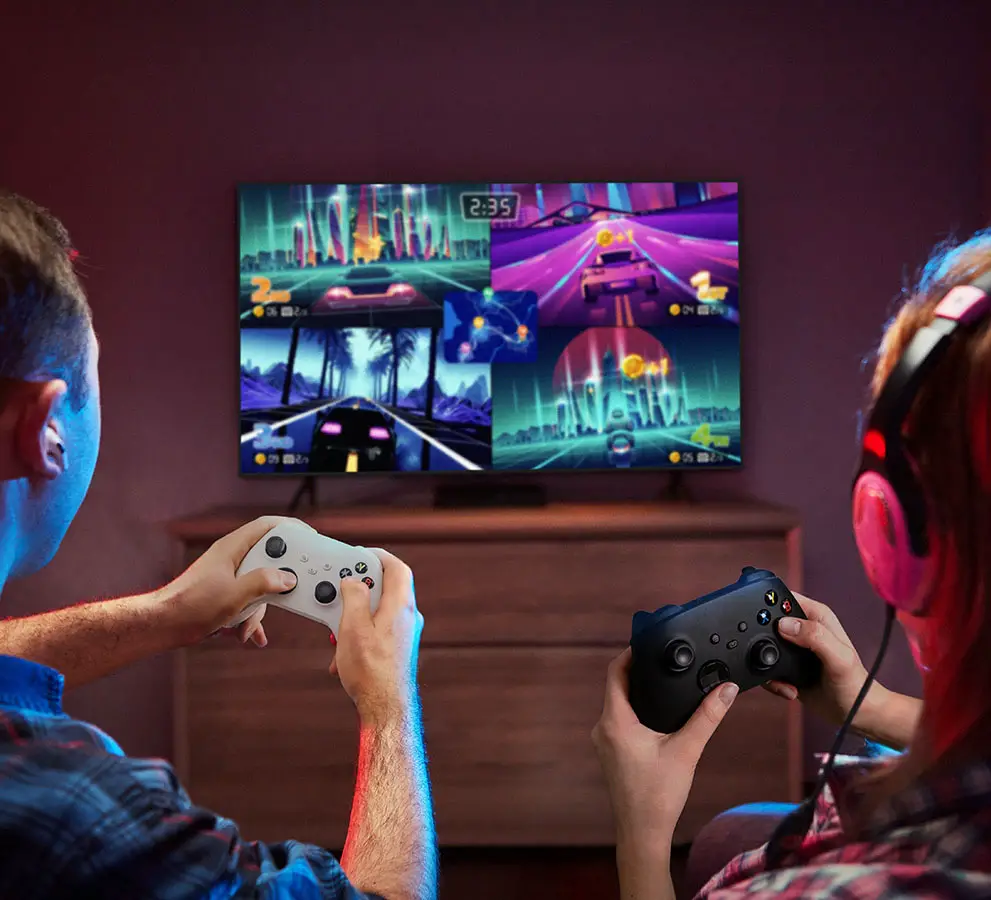
So to make things slightly clearer the UHZ50 projector can do a maximum of 60Hz refresh rate in 4K or it can do 60Hz, 120Hz or 240Hz in 1080p resolution. While for many this may seem a little awkward it is basically the same limitation we saw in many other gaming projectors that claim 240Hz gaming. And we are not so much surprised by this to be honest.
For the cost of the UHZ50 we were not expecting to get a projector with HDMI 2.1 that can also output 4K resolution even at 120Hz. Projectors for that are coming slowly, but we are not there yet.
Now as for its motion performance the projector does come with the usual frame interpolation feature that Optoma has been calling PureMotion. This feature can be used in 3 different settings or turned off completely and to be honest from what we saw the UHZ50 did very well even without it. But if you find the motion a bit bothering then the lowest setting will smooth out slightly the judder and motion blurring. Just keep in mind that you will have to use HDMI 3 for this to work.
Ports & Connectivity
When it comes to its connectivity options the UHZ50 offers a lot of flexibility and reminded us a bit the plethora of ports that was offered in the Optoma UHD51A and UHD52ALV.
Starting from left to right we find 3 HDMI ports, 3 USB ports, an RJ-45 Ethernet port, a digital optical output, a 12 volts trigger, a 3.5mm analog stereo output, a 3-pin 3d-sync port, an RS-232 and the power connector. As you see plenty to go around.
For the USB ports the left one is used only for power distribution to some external dongle while the other two can be used for either connecting a WiFi dongle or some external storage drive since the projector has an internal file manager and media player. With the inclusion of 3 USB ports it means that you can have both a WiFi dongle and a USB flash drive connected at the same time which is very practical and you will not have to plug/unplug devices all the time.
As for the HDMI ports all three of them are HDMI 2.0 and support HDCP 2.2 and this is one of the reasons why the projector can do maximum 4K@60Hz or 1080p@240Hz. But here we find a small problem. It seems that for using the projector’s Enhanced Gaming features and low latency mode you will have to use the HDMI 1 while if you like to turn on the PureMotion feature which is Optoma’s motion interpolation solution HDMI 3 has to be used.
As you understand if you like to both play games and watch movies with motion interpolation you will have to switch between HDMI 1 and 3 which can add a lot of frustration. The only viable solution, other than physically changing cables all the time is to use an AV receiver to do the switching for you.
The UHZ50 doesn’t have built-in WiFi but in the box you get the WUSB wireless adapter which you can plug in one of the two USB ports and allow the projector to connect wirelessly. The dongle supports only 2.4Ghz networks and IEEE 802.11 b/g/n.
OS, Apps and Features
Last but not least is the section where we will go through the OS and all the extra features available on the projector. It seems that unlike previous Optoma projectors the UHZ50 comes with Optoma OS which basically is a modified Android OS.

The Home Screen of the UHZ50 really reminds us more of a TV UI as Optoma has designed it in a way that is easy to understand and pleasant to navigate around. Everything is positioned at the bottom and from the left we have four circular icons for the OSD projector menu, settings, source selection and Apps. Next there are three bigger icons for Optoma Connect, Creative Cast and File Manager and at the right you can choose one of the three available HDMI ports for quick switching.
The OSD menu is where you will find all the projector options and this is no different than what we have seen in many other projectors. The only difference is that Optoma has nicely intergraded it into the modified Android OS in order for the transition to feel more seamless. The settings menu have a few options that you can change through the Optoma OS while the source selection and Apps icons are pretty obvious what they do. One thing to keep in mind is that there are no pre-installed apps in the UHZ50 so everything will have to be downloaded from Optoma Marketplace.
The first of the bigger icons is Optoma Connect and this is an app you download in your mobile device and through that you can customize the Infowall of the projector with various info customized specifically for you. This is essentially the same function we had seen in the CinemaX P2 some months ago.
Next is Creative Cast and this has two functions actually. The first one is that with it you can stream content from your smartphone, tablet, or laptop without the use of cables. Its second function is that it can be used as a remote to control the projector with. And since we mentioned controlling the projector, the UHZ50 works with both Amazon Alexa and Google Assistant if you have an external voice control device that accepts your commands while there is also IFTTT home automation integration.
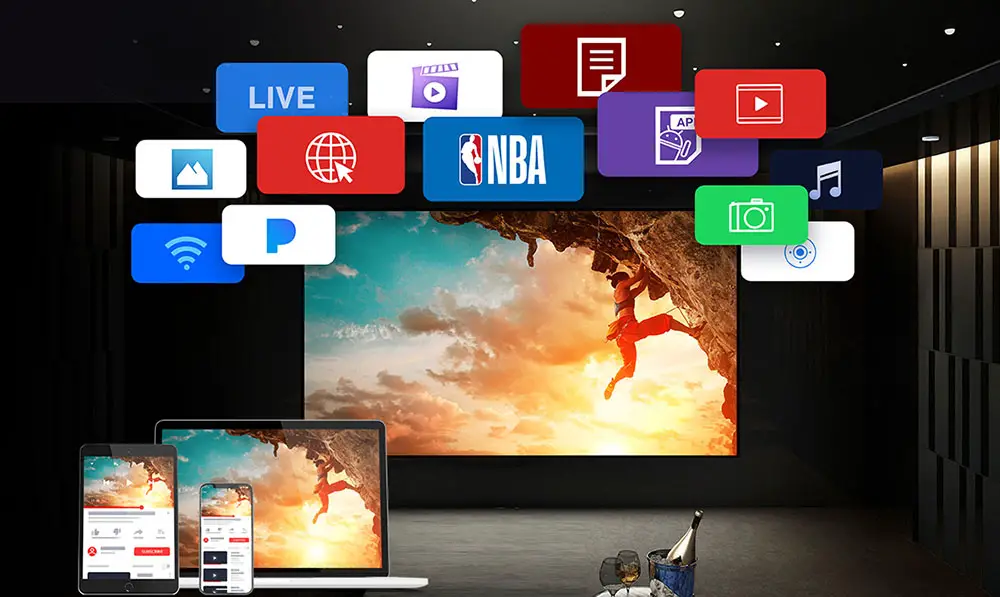
Lastly there is File Manager and this is a pretty comprehensive feature that lets you scan all the files that your projector can detect either in its internal storage or from the cloud. Through the file manager you can use the projector’s built-in media player and from what we saw it is very capable at playing the most common of codecs and video files.
The list of supported codecs and media is extensive including MPEG1/2, MPEG4, H264 and H265 along with AVS and VC1 for video while the list extends to various audio files and images. There is even the ability to view PDF and Microsoft Office files which can be useful if you want to use the projector for presentations.
One interesting feature that we also saw in the UHD35 is what Optoma calls Wall Color Adjustment. With the “Wall Color” setting, you can alter the projected image based on the color of your wall in case you don’t have a screen or if you plan on using it outdoors. With six options to chose from you can easily adjust for blackboard, light yellow, light green, light blue, pink and grey walls to get the most accurate color gamut.
The projector also features a built-in sound system but as always this should be used only for portability purposes and in no way it can do anything substantial in a home theater or entertainment room. Its dual 10 watts speakers have good volume but overall output felt a bit flat and uninspiring. It’s good to have it as an extra option, just don’t expect anything amazing out of it.
Overall the UHZ50 scored pretty high here. The Optoma OS offered a solid experience, there are plenty of apps in the marketplace to choose from, the UI was nice and simple and the built-in file manager and media player give you a lot of flexibility in terms of file support and playback capabilities.

Final Thoughts
Optoma is no stranger to low cost and affordable projectors and the UHZ50 is a prime example of how Optoma has refined their art in this below $3,000 price category. The unit managed to do very well across the board and as a result it can be considered an excellent all around projector no matter its use.
We loved its very detailed 4K images, even for a 4K pixel shifter, good out-of-the-box performance that can be further improved with deeper calibration, satisfying brightness, black levels and shadow detail that were better than what most lamp based projectors of the same category can do and a Optoma OS that is a heavily modified Android with plenty of support from apps and Optoma’s own systems. Lastly its low input lag makes it an excellent choice either you want to use it for movies or gaming while 3D support will keep your 3D collection alive for a few more years.
As for its downsides the projector cannot support anything more than 4K@60Hz meaning that 120Hz and 240Hz are available only in 1080p. The projector has no HDMI 2.1 ports while if you want to use both Optoma’s PureMotion and Enhanced Gaming features prepare for some cable switching as different HDMI ports support these two. Also with Enhanced Gaming certain functions are turned off. Lastly the built-in audio system is really mediocre so if you are going to install this in a home entertainment room then we strongly suggest of a better audio solution.
Closing our review we cannot say that we were not impressed by the Optoma UHZ50. It is a very solid offering and while at first glance it may look more like a game oriented option in reality it is a great mixed use projector that can perform equally good both in movies and video games. Laser projectors start to become the norm and not without good reason. And the UHZ50 surely points the road forward.

For more reviews you can check our dedicated 4K Projector reviews list or even look at our Product Reviews Table where you can find the brand and specific product you are looking for.
Cheapest Places to Buy :
*We are a reader-supported website. When you buy through links on our site, we may earn a small affiliate commission at no extra cost to you. Home Media Entertainment does not accept money for reviews.*
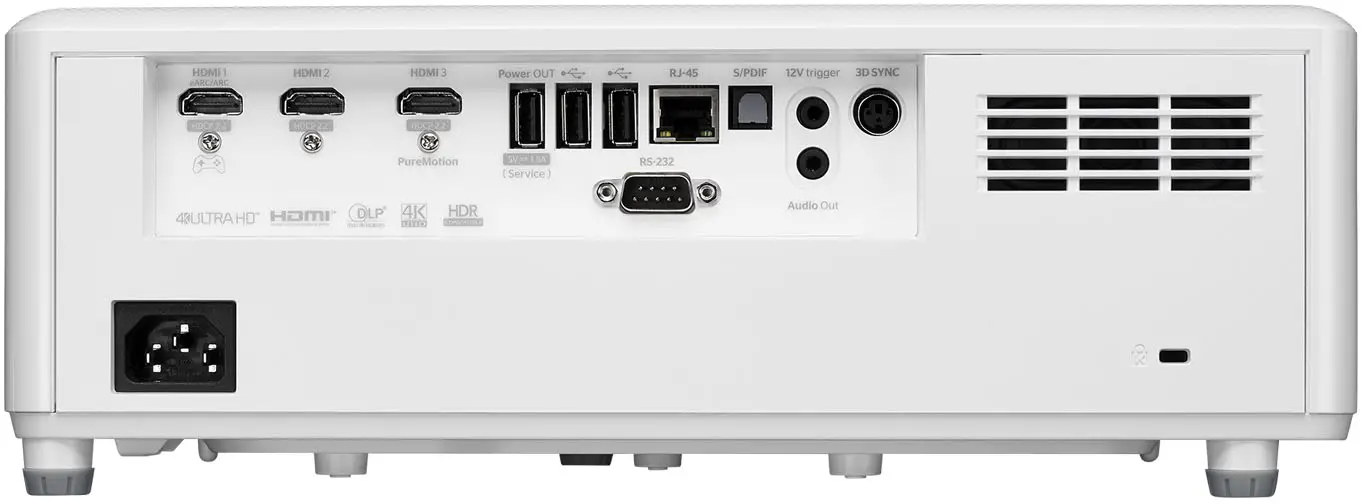
It seems that there are many new projectors that can do 120Hz but only in 1080p resolution. I am eyeing for a new projector but I will wait for one that can do 4K@120Hz. I don’t care about 240Hz as I am more of a console user but 4K@120Hz should be the standard for any gaming projector nowadays.
Hey Chris. Projectors are still lagging in this area compared to TVs. It will take some time until 4K@120Hz can be a sure thing with projectors. Surely they will come, but technology is not there yet.
I hate to see that Optoma is calling pixel shifting as true 4K UHD resolution which is far from the truth. I have nothing against pixel shifting, in fact I have seen a few of them and they surely look great but I don’t get the point why they market them as such.
It’s because they can. It’s disappointing to see this really, but the best way to combat this is for people to educate themselves before any new purchase. Only then you know for sure what you buy no matter the kind of advertising manufacturers make.